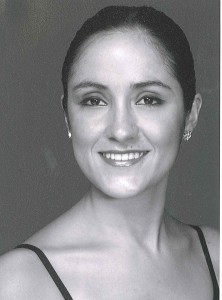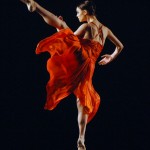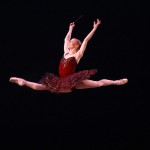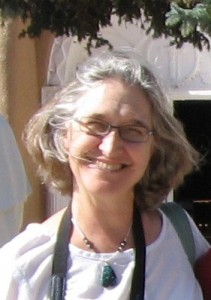Want to know who is more fit when you compare international swimmers and international ballet dancers? Check out the findings on this Scientific Blogging site–then let me know if you expected the answer–or if you were surprised.

A website for dancers, dance teachers and others interested in dance
by 4dancers
Want to know who is more fit when you compare international swimmers and international ballet dancers? Check out the findings on this Scientific Blogging site–then let me know if you expected the answer–or if you were surprised.

by 4dancers
Today we have an interview Elisa Toro Franky–a 2010 competitor in The USA International Ballet Competition. Representing Columbia, she studies at Dance Theatre of Harlem and credits Arthur Mitchell as the most influential person in her dance career. (Arthur Mitchell is the 2010 USA IBC honorary chairperson.)
4dancers will be featuring other people who are associated with this “olympic-style” competition over the coming weeks, so stay tuned. And now…Elisa…
1. How did you wind up a dancer?
When I was a child, my parents always encouraged my brother and me to explore different activities besides the normal school. Art has always been highly important in my family, and therefore, when I was 8 years old, my mother suggested me to start Ballet classes. I was captured by Ballet from the very first lesson, and as years went by, I chose to pursue the dream of being a professional ballerina.

2. What road has taken you to the USA International Ballet Competition?
Since I heard about the USA International Ballet Competition in 2005, I saw it as a fabulous challenge for a dancer; the ideal scenario to offer one’s talent and hard work, while learning from excellent dancers from all over the world.
I applied for the 2006 USA IBC, without success. Since then, I have had the chance to learn and to gather performing experience during the last 4 years with the Miami City Ballet, then with the Washington Ballet, and now with the Dance Theater of Harlem. This has propelled me into the selected group of competitors for the 2010 USA IBC.
3. How have you prepared yourself for this competition, both physically and mentally?
Physically and mentally go together. I focused on the development of the physical strength required for each solo, exploring every movement transition, every corner of motion. I reflected a lot about the energetic shape for each role. In addition, the encouragement and support I received from my family, friends and co-workers was crucial in the process.
4. Do you have any advice for other dancers who are going to compete in dance?
Be very organized in the preparation process and do not waste valuable time. It is all about self-discipline and love for your art.
5. You have said that Arthur Mitchell is the most influential person in your dance career…can you explain why that is?
He is such an honorable man! He created a company that welcomes all races in one stage, where it is the mere quality of the craft that is important, not the race or the ethnicity. He opened a door for equal opportunities for African-American dancers and for dancers from over the world, and they excelled before a worldwide audience. Arthur Mitchell is respected and truly admired by all of us at the Dance Theatre of Harlem.
6. What is it like to study at Dance Theatre of Harlem?
I believe that the diversity of their repertoire made me a versatile dancer, which is essential in a dance career. The artistic faculty is there to coach us, to guide us toward the greatest dancers we can become. However, they are very strict and demanding, which impulses us to higher levels of performance.
7. Would you share something special from your dance career so far?
I find special the fact that I willingly left my country, my family and friends, in order to pursue advanced studies and a professional dance career in USA. I was 17 years old when I had to go far away from my nest in Colombia, so I could get closer to a professional Ballet environment abroad.
8. Have you had any challenges in terms of your career so far?
Everything has been a challenge, I approach it that way. Earning soloist roles, auditioning, going on tour, experimenting with my own choreography for the first time!
9. Who are your favorite dancers?
Viviana Durante, from the Royal Ballet, to mention one of many dancers I admire.
10. What is next for you?
I am looking forward to continue to dance with the Dance Theatre of Harlem Ensemble. I am looking forward to the concrete projects they have for re-opening the main company. That has been the greatest hope cherished at DTH during the last few years.
About the competition: The USA International Ballet Competition is a two-week, “olympic-style” competition where tomorrow’s stars vie for gold, silver and bronze medals; cash awards; company contracts; and scholarships. The event is designated as the official international ballet competition in the United States by a Joint Resolution of Congress. Presented under the auspices of the International Dance Committee, International Theatre Institute of UNESCO, the USA IBC is held every four years in Jackson, Miss., in the tradition of sister competitions in Varna, Bulgaria, and Moscow, Russia.
For more information about USA IBC, visit www.usaibc.com or join our Facebook community.
by 4dancers
If you are a Twitter user, the hashtag is your friend.
Hashtags are the # symbol, and on Twitter they are used to mark a certain subject for a search. For example, if I were to do this: #dance, it would categorize my tweet under dance in a search for that subject. While it doesn’t guarantee that people will find your tweets–it can really help!
Want to learn the details? Take a look at the Twitter page that gives you all the details.
by 4dancers
Join us here at 4dancers over the next few weeks for a closer look at some of the people involved with the USA International Ballet Competition.
We’ll be talking with a competitor 2010 as well as others. If you have not yet heard of this wonderful event…take a closer look…

In this two-week, “olympic-style” competition; tomorrow’s stars vie for gold, silver and bronze medals; cash awards; company contracts; and scholarships. The event is designated as the official international ballet competition in the United States by a Joint Resolution of Congress. Presented under the auspices of the International Dance Committee, International Theatre Institute of UNESCO, the USA IBC is held every four years in Jackson, Miss., in the tradition of sister competitions in Varna, Bulgaria, and Moscow, Russia.
Professional and amateur dancers of all nationalities compete in two divisions: Junior Division (ages 15-18) and the Senior Division (ages 19-26).
For more information about USA IBC, visit www.usaibc.com or join their Facebook community.

Check back for the first interview this week with 2010 competitor, Elisa Toro Franky.
by 4dancers
Today we have with us Meg Mahoney, a dance educator…
1. Can you tell readers how you became involved in dance and a bit about your background?
I started dancing late (18), when I was at Carleton College, an academically-focused school, majoring in Asian Studies. Dance was part of the PE department, but it was an inspiring class — taught by a professional dancer, Linda Osborne, who commuted from the Twin Cities. Linda danced in a company lead by Margret Dietz, a fabulously inspiring woman who had danced with Mary Wigman in Germany, and whose circle of students I joined. Unfortunately, Margret died in ’72, just after I graduated. I spent some time soaking up inspiration from her company while they were still together, but from there I moved to an artists’ community in Washington State, where I taught, choreographed & did some performing.

Think early 70s… a picturesque little town, an artsy community, funky jobs, bartering garden produce & art for food & services… add some hippie-looking folks to the picture & you’ll get the idea. I took classes and workshops wherever I was and whenever I could. Eventually I emerged & spent a year in NYC getting certified as a movement analyst at the Laban/Bartenieff Institute and then moved to Seattle, where I spent ~7 years teaching creative movement, modern, tap & what-have-you at private studios & preschools in Seattle.
Just after we started a family, my husband & I took a 2-year hiatus in Japan (oh my gosh, we’ve settled down?). After returning, I decided to give up teaching dance and get certified as a teacher (health benefits… consistent pay… school-schedule vacations…). I was a classroom teacher for 4 years, and then I found myself happily building a dance program in my current location, where I’ve been the only full-time dance specialist in Seattle School District for the last 10 years or so.
2. Do you have a “dance philosophy”?
Hmmm… not really! Dance is a prism with a kajillion facets, all of them fascinating… But at various decision-making junctures, I’ve found it valuable to identify my mission & a vision for my work. For a number of years, my mission has been thus: to build relationships, experiences, and exposure for children that guide them to learn, love learning, and live richer lives. That mission has played out in my professional vision — to build a dance program which uses dance as a basic component of education, supporting academic, social, emotional, and physical growth in children, and to expand the program by aiming for excellence, supported by contact with professional colleagues and my own professional development. Although both mission & vision are realities now, the “aiming for excellence” part makes for a forever-journey of growth & change, moving closer & never arriving.
3. You work in the public school system. Can you share a bit about the rewards and challenges?
Rewards: Watching the magic of dance work for all kinds of kids; seeing kids grow as dancers from kindergarten through 5th grade; empowering them to experience themselves as dancers & choreographers by the time they leave. And of course… a steady job; a salary; health benefits, insurance & retirement; a generous helping of vacations throughout the year that fit with a family’s schedule…
Challenges: Classroom management – I like bringing dance to every child in a school, but they’re not all there by choice or easy to reach! Isolation is a challenge – other teachers are great colleagues, but it’s different from collaborating with other artists. A full-time schedule is very consuming & less than ideal. Given a full schedule of teaching & other school responsibilities, it can be hard to take care of yourself physically (providing your own body with the warm-up it needs)!
4. How is working in a school different from teaching in a studio?
So many ways! I get to/have to work with everyone, regardless of their personal interest in dance. I get to/have to integrate other content areas. I get to/have to teach 30-40 classes per week, depending upon the schedule worked out by the school. I get to/have to work with boys & girls from many different cultures & income levels. The choice between “get to” & “have to” really depends upon your personality & goals. Working in a public school is the right place for me, because it gives me a chance to introduce dance to kids & families that wouldn’t have it otherwise.
5. Do you have any tips for those who will be teaching in a school?
Work on pedagogy & management! Understand the conceptual approach to teaching dance (a la Rudolf Laban, Anne Green Gilbert, Dance Education Laboratory at the 92nd Street Y Harkness Dance Center). Cultivate your knowledge, skills & an appreciation for hiphop. Plan on building your own position…
6. Can you tell readers a bit about your blog—how it came to be and what type of content it has?
I started it as a way of reflecting on (and improving) my teaching through reflection – and in order to connect with professional colleagues – both of which are aspects of my professional vision (question 2).
7. Would you share a highlight from your dance life with readers?
All of my best memories have to do with moments of exploring new territory:
The common thread is the growing/learning I’ve always found in dance.
8. What has made dance such a central part of your life?
I’ll defer to the “Why Dance Matters” entries on my blog!
9. Do you have any favorite dance figures? If so, who—and why?
When I’m watching professional dance, I’m looking for great choreography & dancers who can bring it to life. A few choreographers that come to mind are Alvin Ailey (Revelations is exhilarating every time I see it), Mark Morris (he devises fabulous patterns with multiple dancers), Pat Graney (quirky, original, thoughtful), Paul Taylor (I’ll never forget the first time I saw Esplanade). And it’s for the choreography that I watch SYTYCD (once the audition part is over).
As for memorable dancers, they’re not necessarily trained & they don’t do tricks. What they have is commitment! I think of Elijio, the 6-year-old who drives me crazy in class but totally nailed a full-out performance with his 1st grade class last week… of a stately couple dancing on an outdoor stage one Sunday in Merida in the Yucatan last year… of my friend’s son Josh who totally stole the show when he took the stage in his high school production of Beauty & the Beast last week!
10. What’s coming up on the horizon for you?
I’m investigating knee surgery. Medial compartment osteoarthritis has pretty much side-lined me over the last few years, and I’m hopeful that a partial knee replacement is going to put me back on my feet this summer.
As for my teaching life, I’m always looking for ways to accomplish more with my students: more dance styles, better technique, greater comprehension, more videos of dance, dances from more countries…
Meg Robson Mahoney has been a full-time Dance Specialist at Wing Luke Elementary School in the Seattle School District since 1996. Previous incarnations include: reading and math specialist; 5th-6th grade classroom teacher; English teacher in Japanese middle and high schools; Movement Educator in private schools and studios. Honored by the KCTS Golden Apple Award in 2006 and as NW District AAHPERD Dance Educator of the Year in 2002, she served on the Board of Dance Educators Association of Washington for 10 years and continues work with the Arts Assessment Leadership Team of the Office of Public Instruction. Degrees include a MIT from Seattle University, Certificate of Movement Analysis from Laban/Bartenieff Institute of Movement Studies NYC, and a BA in Asian Studies, Carleton College. A mother of two, she lives in Seattle, maintaining a garden and a blog: http://dancepulse.wordpress.com.
This site sometimes features advertising, affiliate marketing, or affiliate links, such as Amazon Associate links and others. When you click on these links, we get a small sum that helps to support the website operations. Thank you! There’s more detailed information on ads and our disclosure policy under the About tab in our navigation at the top of the site. We clearly mark any and all posts that contain these features.
Please note that all of the content on 4dancers.org is copyrighted. Do not copy, utilize, or distribute without express permission. We take cases of infringement seriously. All rights reserved ©2022.